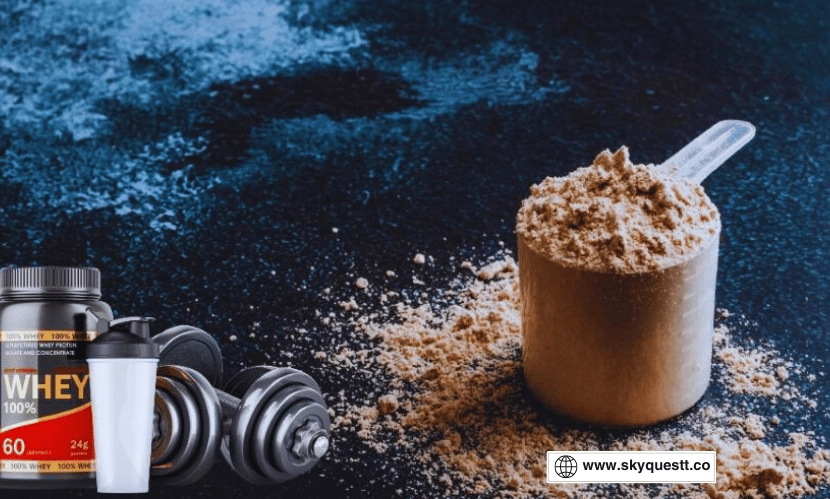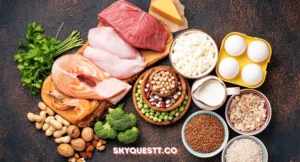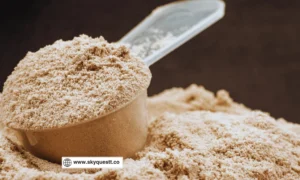
Whey Protein Powder
It starts with cow’s milk, which is naturally made up of two main proteins: casein (80%) and whey (20%). During cheese production, the milk is heated to eliminate bacteria, causing it to separate into solid curds and liquid whey.
Once the curds are strained out, what remains is liquid whey, which consists mostly of water along with protein, fat, carbohydrates, and lactose. This liquid whey is then filtered and dried through a series of steps, transforming it into the whey protein powder commonly used in supplements today.
Step by Step Process
From cows peacefully grazing in the lush, green pastures of New Zealand to the convenient delivery of a flavored protein blend right to your doorstep, the journey of whey protein powder is a fascinating process. Let’s explore each step in detail, uncovering how this high-quality supplement is crafted from farm to finished product.
1. Cow’s milk:
Whey protein is an animal-derived product sourced directly from the dairy industry. The milk used comes from cows that roam freely in the fresh, open air of New Zealand. These cows are exclusively grass-fed and raised without the use of antibiotics or growth hormones (rBGH), ensuring the highest quality milk. In its natural form, milk is composed of approximately 5% lactose, 4% fat, and 3.5% protein, making it a nutrient-rich base for producing premium whey protein.
2. Transport:
The cooled milk is swiftly transported to the nearest processing facility in large, refrigerated tanks to preserve its freshness and quality. This careful handling ensures that the milk arrives at the factory in peak condition, ready for the next stage of whey protein production.
3. Pasteurization:
Freshly collected milk naturally contains bacteria that can be harmful to humans, so it must undergo pasteurization before it’s safe to consume. To eliminate pathogens, the milk is quickly heated to around 73°C and then rapidly cooled. This process effectively removes bacteria without impacting the valuable nutrients in the milk. Once pasteurized, the milk, which contains 20% whey and 80% casein, is ready for the next stage of transformation.
4. Milk Separation:
To initiate the curdling process, enzymes like chymosin are added to the pasteurized milk. These enzymes alter the structure of casein, causing the milk to solidify into curds. The curds, which form the bulk of the milk, serve as the foundation for producing a wide variety of cheeses. Meanwhile, the leftover liquid is whey, which will undergo further processing to become whey protein.
5. Micro-filtration:
The liquid whey is then sent for filtration, where it is refined into high-protein liquid whey. During this stage, the whey undergoes a natural purification process in a cold environment, where fats, carbohydrates, and excess water are removed. Using an array of ceramic micro-filters, the liquid whey is carefully filtered to eliminate most of the fat and lactose. This creates a purer product, forming the foundation for whey protein concentrate.
6. Ultra-filtration (for WPI only):
To create whey protein isolate, whey concentrate undergoes an additional ultra-filtration process. This advanced filtration technique, based on size exclusion, allows the lactose-rich liquid to pass through while retaining the larger whey protein molecules. At this stage, nearly all the fat and lactose are removed, resulting in an exceptionally pure and high-protein whey isolate.
7. Spray Drying:
The high-protein whey liquid is then transferred to a specialized dryer, where a precise combination of hot and cold air quickly removes any remaining water. This spray-drying process is carefully controlled to preserve the whey’s nutritional integrity, ensuring the protein remains undenatured. Once the residual moisture has evaporated, what’s left is a fine powder, rich in protein and ready for further processing.
8. Quality Control:
The unflavored whey protein powder undergoes rigorous quality testing to ensure it meets precise nutritional standards. The protein content is carefully measured, with the final product containing an impressive 80 to 90% protein. This ensures a high-quality supplement, ready to be flavored and packaged for consumers.
9. Blending:
The plain whey protein powder is packaged and sent to the final facility for blending with other ingredients. At Go Good, only organic flavors derived from fruits and superfoods are added, along with thaumatin—a powerful natural sweetener—and non-GMO sunflower lecithin, which enhances solubility in liquids. This careful selection of ingredients ensures a high-quality, delicious, and easily mixable product.
10. Packaging:
At last, the flavored whey protein powder is packaged into 1kg recycled cardboard canisters and sealed. To ensure consistency and quality, a sample from each batch is sent to a lab. There, an infrared machine precisely measures the levels of protein, fat, carbohydrates, amino acids, and other components, guaranteeing the product meets high standards before it reaches consumers.





